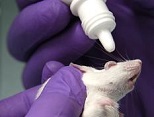Effectiveness of Povidone-Iodine 1% Eye Drop on Streptococcus pneumoniae and Escherichia coli Induced-Keratitis in Mice
DOI:
https://doi.org/10.31661/gmj.v8i.1161Keywords:
Streptococcus pneumoniae, Keratitis, Cornea, Escherichia coli, MouseAbstract
Background: Bacterial keratitis is an ophthalmic infection that may result in irreversible corneal damage. This study aimed to examine the effectiveness of povidone-iodine eye drop 1% in eye infection caused by inoculation of Streptococcus pneumoniae and Escherichia coli of mice. Materials and Methods: In this study, 49 adult male CBA/J mice were used that divided into seven equal groups. The corneas of all mice were scratched and infected with a clinical strain of either S. pneumoniae or E. coli topically, except control group. Subgroups received chloramphenicol 0.5% eye drop twice daily in case of S. pneumoniae infection or ciprofloxacin 0.3% eye drop every 4 hours following E. coli infection from or povidone-iodine 1% eye drop in both groups, from post infection (PI) day 3 to7. Slit lamp examinations (SLE) of the corneas and eyes were performed every day to examine detectable or intense corneal opacity and erosion. Results: In all infected mice, SLE scores were significantly higher than the control group on PI day 3. Scores increased steadily by time in all infected groups without treatment, reached to maximal value on PI day 7. In infected groups, treatment with either povidone-iodine 1% or chloramphenicol 0.5% or ciprofloxacin 0.3% on day 3, significantly decreased the SLE scores on PI day 7. Conclusion: Povidone-Iodine 1% was effective to decrease S. pneumoniae and E. coli induced-keratitis symptoms in mice. Treatment with povidone-iodine 1% was observed time-dependently and was comparable to common eye drop antibiotics. [GMJ.2019;8:e1161]
References
Bhave P, Chamie G. Streptococcus pneumoniae keratitis. J Hosp Med. 2008;3: 353. https://doi.org/10.1002/jhm.306PMid:18698596 Wagoner MD, Al-Ghamdi AH, Al-Rajhi AA. Bacterial keratitis after primary pediatric penetrating keratoplasty. Am J Ophthalmol. 2007; 143:1045-1047. https://doi.org/10.1016/j.ajo.2006.12.035PMid:17524776 Callegan MC, O'Callaghan RJ, Hill JM. Pharmacokinetic considerations in the treatment of bacterial keratitis. Clin Pharmacokinet. 1994; 27:129-149. https://doi.org/10.2165/00003088-199427020-00005PMid:7955776 American Academy of ophthalmology, Basic & Clinical Science course, External Disease and Cornea. 2005; 8: 855-860. Marimon JM., Ercibengoa M, Garcia-Arenzana JM, Alonso M, Pee'rez-Trallero E, Streptococcus pneumoniae ocular infections, prominent role of unencapsulated isolates in conjunctivitis. Clin Microbiol Infect. 2013; 19: E298-E305. https://doi.org/10.1111/1469-0691.12196PMid:23517475 Oliveira LA; Takata TT; Shiguematsu AI; Soares Melo Júnior LA; Gompertz OF, Sousa LB, Mannis MJ. Effect of topical 0.5% povidone-iodine compared to 5% natamycin in fungal keratitis caused by Fusarium solani in a rabbit model: a pilot study. Arq. Bras. Oftalmol. 2008; 71(6), online. https://doi.org/10.1590/S0004-27492008000600018PMid:19169521 Isenberg SJ, Apt L, Valenton M, Sharma S, Garg P, Thomas PA, Parmar P, Kaliamurthy J, Reyes JM, Ong D, Christenson PD, Del Signore M, Holland GN. Prospective, Randomized Clinical Trial of Povidone-Iodine 1.25% Solution Versus Topical Antibiotics for Treatment of Bacterial Keratitis. Am J Ophthalmol. 2017;176:244-253. https://doi.org/10.1016/j.ajo.2016.10.004PMid:27984024 Apt L, Isenberg S, Yoshimori R, Paez JH. Chemical preparation of the eye in ophthalmic surgery: Effect of povidone-iodine on the conjunctiva. Arch Ophthalmol. 1984; 102: 728-729. https://doi.org/10.1001/archopht.1984.01040030584025PMid:6721765 Quincy C, et al. Development of a Streptococcus pneumoniae Keratitis Model in Mice, Ophtalmic research. 2009;42:141-146. https://doi.org/10.1159/000229028PMid:19628954 PMCid:PMC2790775 Barkana Y, Almer Z, Segal O, Lazarovitch Z, Avni I, Zadok D. Reduction of conjunctival bacterial flora by povidone-iodine, ofloxacin and chlorhexidine in an outpatient setting. Acta Ophtalmologica candinavica. 2005; 83: 360-363. https://doi.org/10.1111/j.1600-0420.2005.00414.xPMid:15948791








